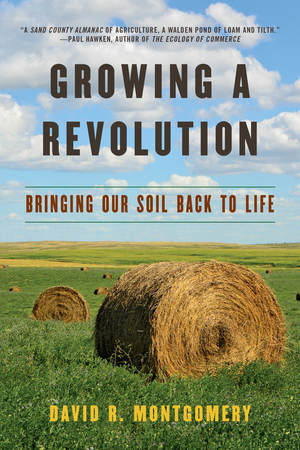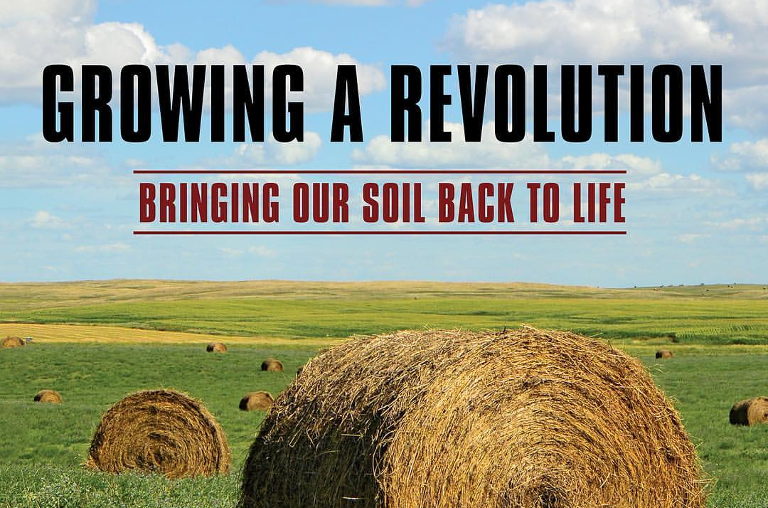 Growing a Revolution: bringing our soil back to life
Growing a Revolution: bringing our soil back to life
by David R. Montgomery
W. Norton & Company 321 pages
$19.58 hardcover, $11.52 paperback, $9.88 Kindle, $26.29 audio CD
Resilience.org asked me to review this book, probably because I did a multibook review five years ago in which I compared four books on sustainable gardening and farming.
Growing a Revolution, unlike the four books I reviewed then, is not really a how-to book. While it might well be useful to farmers, its primary purpose is to show the many benefits of changed agricultural practices, and it includes talk about policy changes that would be helpful.
Montgomery is a geologist. He has written four previous books, mostly with an ecological theme. Here he looks at what he calls “conservation agriculture,” which really boils down to three principles:
- Do not till the soil.
- Use cover crops or mulch; keep the soil covered.
- Rotate crops.
He takes a global journey, visiting practitioners of this type of farming in North and South Dakota, Nebraska, Ghana, Costa Rica, Ohio and Pennsylvania. Their circumstances differed considerably as did their land; what they had in common is that they used all three of these practices. It was several times emphasized that one of these (for example, no-till) would not likely reap the benefits of using all three.
In the first paragraph of the preface, he says, “Since the dawn of agriculture, society after society faded from memory after degrading their soil. But we need not repeat this history on a global scale. For while the problem of soil degradation remains the least recognized of the pressing crises humanity faces, it is also one of the most solvable. Are you ready for an optimistic book about the environment?”
And it is optimistic, because while it recognizes the problem—almost every farmer Montgomery visits shows him the hard (or powdery), pale, lifeless soil of a neighbor using conventional farming to contrast with his or her own deep, dark, soft, rich soil—there is also abundant evidence that this approach to farming is catching on. Bottom line—it saves farmers money. Other bottom line: after a transition period, it produces equal or superior yields, especially in drought years. But there are some barriers to adaptation.
One serious issue for US farmers is that converting from conventional farming often requires enduring a year or several of lowered yields before the benefits are apparent. For farmers in debt, struggling to survive each year, this can be problematic. Crop insurance is another problem, as it apparently is limited to conventional systems. Another US barrier is in the field of research; the great majority of research money goes to “products, not practices,” which some of the farmers blame on the influence of the conglomerates that want to sell to farmers. The likes of Monsanto, Pioneer, and Cargill have influence at USDA and research universities. And they aren’t interested in research in how to get good yields while using less, or no pesticide, fertilizer and diesel fuel.
An eye-opening transition comes early on, after Montgomery finishes with his Great Plains tour, riding in a monstrous tractor high over the plains, “feeling like I’d entered the command center of a two-seater prairie starship.” A memory stick is entered and “I followed our progress on a bank of readouts,” using GPS and various data about inputs, later correlated with yields. From there he goes to the Center for No-Till Agriculture in Ghana. Here people are working tiny holdings, mostly using hoes and machetes—and sometimes sharpened sticks. And yet the principles its director conveys to farmers in his region are largely the same as those used in the Dakota prairies. There are added challenges here: tropical rains leaching nutrients from the soil, a growing population, and poverty limiting possibilities for the mostly subsistence farmers. The African center features many side-by-side comparison plots; actually showing farmers that a different approach can work better than the methods they’re used to is effective here just as it is elsewhere in the world. Every one of the farmers Montgomery visits uses his farm for demonstration purposes.
One question that came up was whether no-till methods would work with organic agriculture; many no-till farmers rely on herbicide for weed control, though those using careful crop rotation and cover crops may use much less. Montgomery went to the Rodale farm in Pennsylvania for answers to this question. Here he saw the roller-crimper in operation; this is a heavy roller bar with knobs on it, rolled over a field to kill a cover crop before—or while–sowing the next crop without removing the residue. But they plow about one year in three to deal with perennial weeds.
In North Dakota Gabe Brown uses all three of the conservation practices plus one more—rotational grazing. His farm is thriving under this system. When asked how we could get more conventional farmers to change, he said, “Consumer demand—you’re not going to get Washington to change.”
The book delves into the biology of soil ecology, where mycorrhizal fungi and bacteria exchange scavenged nutrients with fine plant roots in a commerce he calls “the original underground economy.” He describes how predatory arthropods, protozoa and nematodes feed in turn on the bacteria and fungi involved, and excrete “micromanure” rich in phosphorus, nitrogen and micronutrients. Fascinating—at least to me. But it depends on abundant organic matter in soil, and minimal disturbance. Also multi-year rotation of crops, to disrupt pest cycles—and avoidance of pesticides, which may kill the predators (and the pollinators).
In Ohio he gets into the question of farming practices that sequester carbon, thus helping with climate change along with raising food. Fortunately, the same practices that enhance soil fertility (and foster wildlife, and create wholesome food for humans) also sequester much carbon. Plants don’t directly take up carbon, he says, but it feeds their microbiome. His Ohio contact, Rattan Lal, estimates that half the carbon has been lost from the world’s soils due to plowing. Conservation agriculture can put it back. Estimates of what percentage of greenhouse gas emissions could be offset if all the world’s cropland and rangelands moved to these practices range from five percent to all of it. The same changes also greatly reduce agriculture’s contribution, so it’s probably not less than ten percent. Then there’s biochar, which also sequesters carbon.
In Costa Rica, he visits farmers who use a fermented microbial starter as fertilizer, and terra preta. There is much potential for fertilization and carbon sequestration with terra preta, but it is not uniform; it varies in composition. Also, it isn’t helpful where soil is already fertile. It’s most useful on depleted tropical soils.
One of the last chapters talks about the need to “close the loop” in nutrients by returning organic matter back to the land—meaning animal manures, now collecting by CAFOs and ending up polluting rivers; and human waste, which is composted and sold by some cities; and food and yard waste, which is half the bulk of landfills and should instead be contributing to our land’s fertility.
A sentence from the last chapter sums it up: this approach “simultaneously builds soil fertility to help feed the world and improve food quality, stores carbon to slow climate change and boost agricultural resistance to it, and conserves biodiversity on agricultural land.”
The good news is that despite the barriers mentioned earlier, conservation agriculture is catching on—it’s just happening more slowly, spreading from the ground up as farmers note that the local weirdo using these practices keeps getting better yields. But there are lots of policy changes that could speed adaptation greatly.





